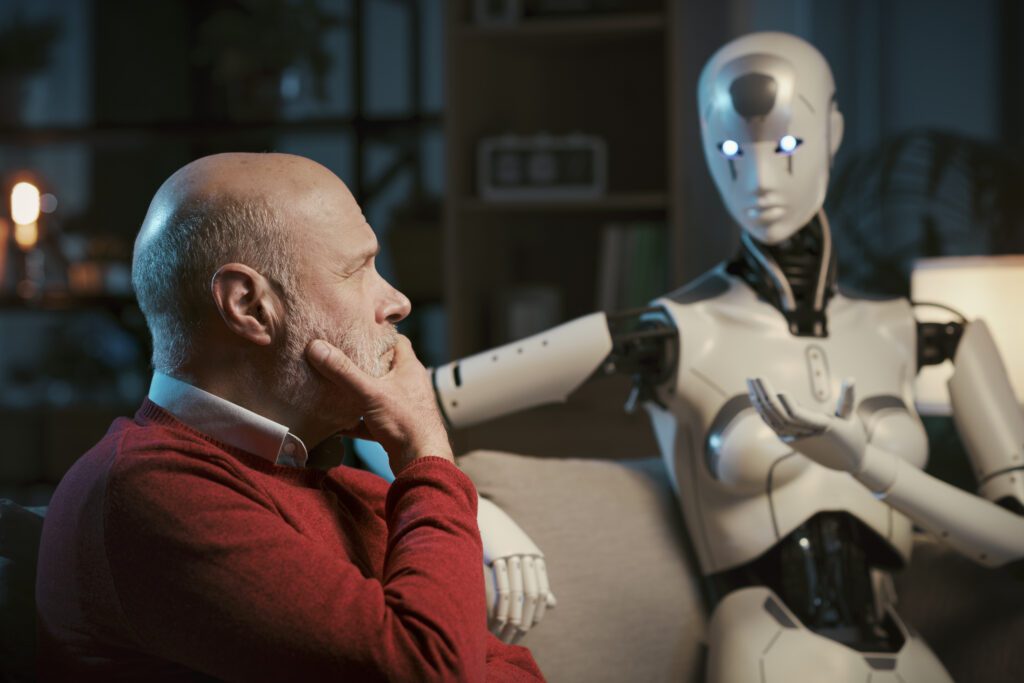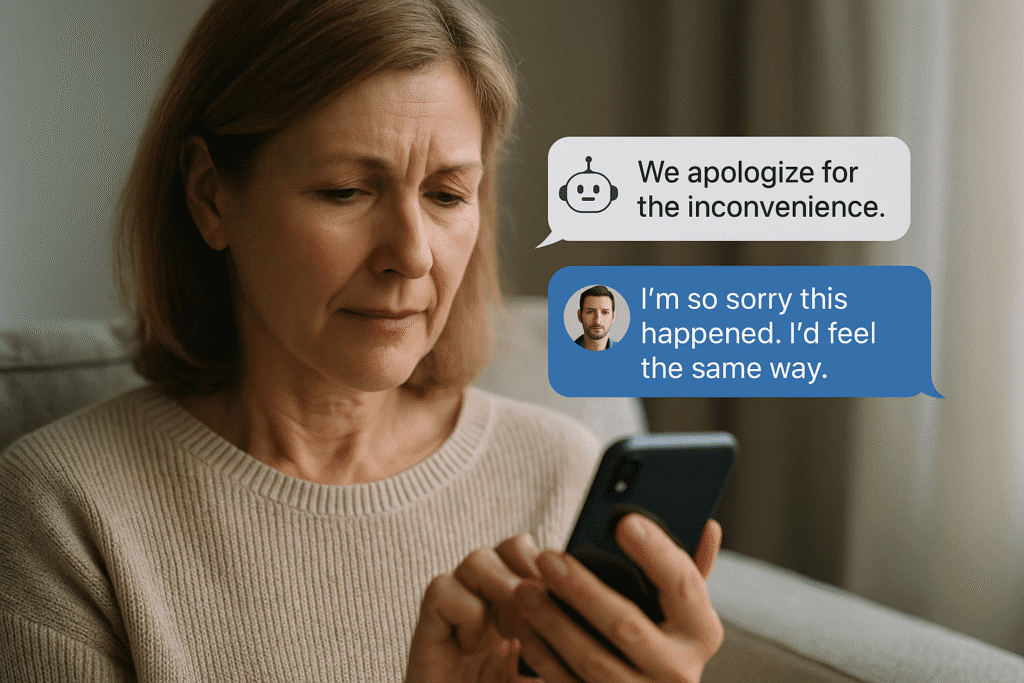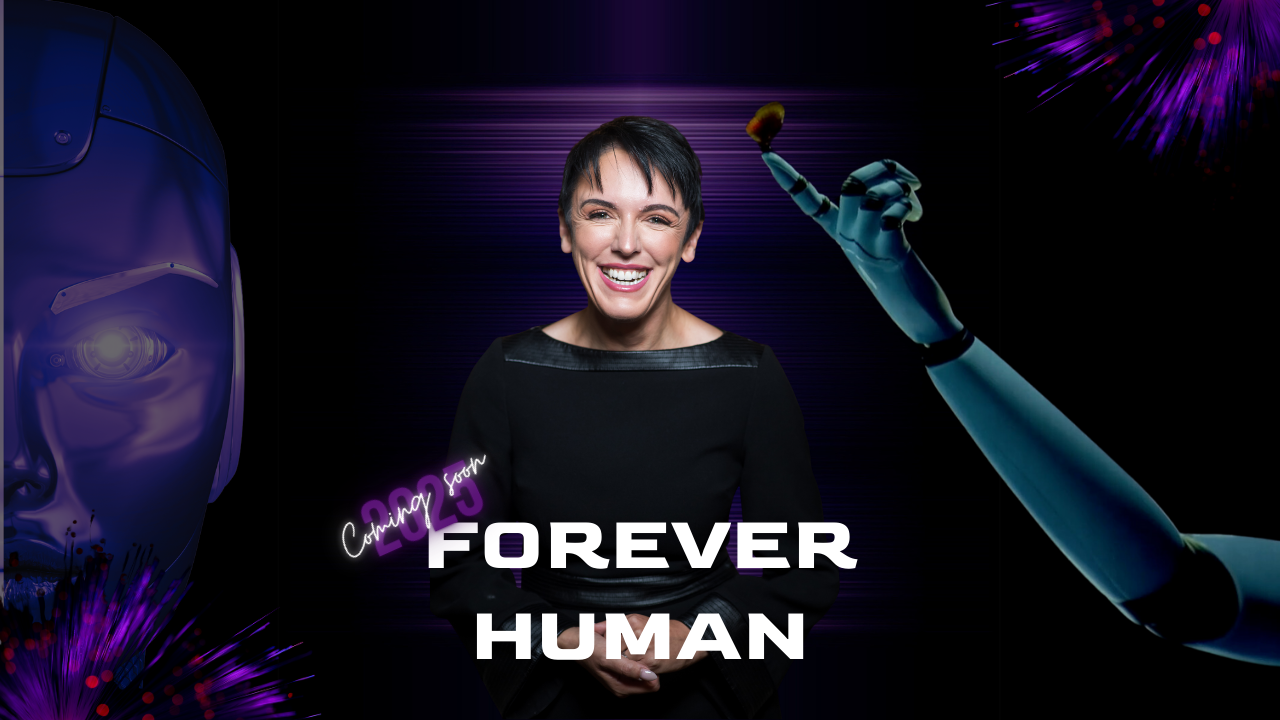AI and Customer Service: The Relationship is About to Get Complicated

When was the last time you spoke to a customer service agent who sounded… human? Not efficient. Not polite. But human. Maybe they remembered your name, offered genuine empathy, or solved a messy issue without putting you on hold for 17 minutes.
Now, think about how many of those moments have been replaced by chatbots, automated prompts, and AI agents with no memory of your frustration from last week.
AI and customer service are on a collision course. And it’s not just changing how fast we get answers; it’s reshaping how customers behave, how employees show up, and what “good service” even means. For businesses, this is more than a tech upgrade. It’s a perception shift—one that could deepen loyalty or quietly drive people away.
KEY TAKEAWAYS
- AI and customer service now intersect in nearly every industry
- Customers are becoming more informed, more impatient, and more selective about how they engage
- Service reps are shifting from problem-solvers to AI supervisors and emotional translators
- Emotional intelligence is emerging as the most irreplaceable skill in customer-facing roles
- Companies that over-automate risk damaging trust and long-term brand equity
- Leaders must redefine service excellence in a world where machines make the first impression
- AI doesn’t remove the need for human connection; it raises the bar for when it actually matters
When Machines Make the First Impression

AI and customer service are now so deeply intertwined that AI isn’t just handling simple requests anymore. It’s greeting your customers before your people do. In many industries, AI is now the first voice, the first reply, the first attempt at a solution.
And while this creates convenience, it also alters the customer’s emotional journey. They arrive at human interaction either relieved… or already irritated.
The psychology is subtle but real: when a chatbot works, customers trust the brand more. When it fails, they don’t just question the bot—they question the business. First impressions have always mattered. But now they’re made in milliseconds, by software. In that compressed moment, there’s a decision being made: Am I respected or dismissed? Am I just a ticket ID or a valued relationship?
Tone, timing, and trust must be engineered into the very first second of service. The irony is sharp—businesses once spent millions training frontline staff to create a great opening impression. Now, those impressions are being shaped by prompts, language models, and response delays. The warmth of your welcome is no longer in your handshake: it’s in the algorithm.
If your AI isn’t aligned with your service philosophy, it’s not just bad UX; it’s bad branding. Worse, it becomes a broken promise.
Warmth used to come from a smile. Now it comes from syntax.
Sylvie di Giusto
The Informed (and Exhausted) Customer

Today’s customers show up armed with information, reviews, receipts, and sometimes screenshots from Reddit. They’ve already searched, sorted, compared, and judged—before they ever contact you.
They’re not looking for help; they’re looking for confirmation that their research was right, or if not, for a convincing reason to change course.
This hyper-informed behavior sounds ideal. But it comes with fatigue. We’re not just dealing with smart customers; we’re dealing with digitally overwhelmed ones. They don’t want to re-explain their issue or navigate another maze of menus. They want to skip to the part where they feel understood.
That’s where AI and customer service either align or collide. AI can either shine or sabotage. If the AI doesn’t surface relevant context, if it forces repetition or ignores history, it turns that fatigue into frustration. And the brand pays the price.
AI has raised expectations, not reduced them. The modern customer expects the interaction to be frictionless, predictive, and maybe even a little magical. They want responses that feel tailored, not templated. They want proactive support before they even hit “submit.”
In essence, the more your AI tools promise, the more dangerous it becomes to underdeliver. The customer doesn’t care how advanced your systems are—they care whether you remembered them. In a world of instant access and endless options, people don’t want to feel processed. They want to feel prioritized.
Customers don’t need more answers—they need less exhaustion.
Sylvie di Giusto
From Agents to AI Conductors

Let’s not forget the humans behind the service desk. As AI takes over routine tasks, the role of the customer service rep is quietly transforming. They are no longer expected to handle volume. They’re expected to handle volatility.
That means emotional escalation, edge cases, and situations where the machine failed. Instead of being script readers, customer service reps must now be improv artists. They need to defuse tension, interpret AI logs, override automation errors, and do it all without sounding like they resent the robot sitting next to them.
The soft skills just became the hard skills. And with that shift comes a new kind of pressure. Agents are now the fail-safe, the escalation point, the emotional intelligence buffer between a frustrated customer and an unforgiving algorithm. It’s no longer about how fast they answer a phone call. It’s about how well they salvage a situation gone sideways.
We’ve entered an era where AI and customer service intersect so closely that it isn’t just about fixing problems. It’s about interpreting meaning. It’s reading between the AI-generated lines, picking up on what the customer didn’t say, and restoring a sense of humanity to a process that feels increasingly robotic.
The future belongs to customer service professionals who are emotionally intelligent, technically literate, and perceptive enough to bridge the gap between algorithm and anxiety. And it belongs to the companies that recognize that emotional labor is not an optional skillset; it’s a strategic advantage.
Script readers are out. Emotional translators are in.
Sylvie di Giusto
Empathy is Not a “Feature”

Here’s a truth AI can’t change: when people are upset, they want to feel heard. Not processed.
While chatbots can simulate pleasantries, they can’t intuit discomfort, detect sarcasm, or navigate nuance with grace. An apology without sincerity is a script. And nothing makes a customer more irritated than being on the receiving end of faux empathy; especially when things go wrong.
Empathy isn’t scalable—not even with the best AI and customer service integration. But it is magnetic. The brands that will win are those who invest in it as a skill, not a setting. Not just in the words used, but in how those words are delivered: with tone, timing, and truth. Real empathy doesn’t rush, doesn’t deflect, and doesn’t try to win. It listens to understand, not to solve.
And here’s the paradox: the more automated customer service becomes, the more noticeable and valuable real empathy gets. It becomes the differentiator that customers talk about, post about, and stay loyal to. Nowadays, most brands sound the same, and the ones that “feel different” will win. That difference is often one person, on one day, who didn’t read a script but responded like a human. AI can handle millions of requests, but only people can truly meet another person where they are.
You can automate convenience. You cannot automate care.
Sylvie di Giusto
Automation without Intention is a Liability

Just because you can automate it doesn’t mean you should. Over-automating customer service and failing to balance AI and customer service with intention creates a brittle system: one that looks impressive in a demo and collapses in real life.
Here’s the risk: every time a machine fails, it erodes trust faster than a human mistake. Why? Because customers assume your AI represents your best effort. A cold response, a missing escalation path, or a misrouted chatbot isn’t interpreted as “a glitch.” It’s interpreted as “they don’t care.”
There’s also a subtle identity cost. Over-automating means outsourcing your voice, your tone, your decision-making instincts until the brand itself feels algorithmic. Customers might not articulate it, but they can feel when a company sounds like software instead of people. That shift creates emotional distance. And emotional distance kills loyalty.
AI should enhance the experience, not hollow it out. If there’s no clear escalation to a human, if the AI repeats irrelevant options, or if it delivers tone-deaf responses to nuanced issues, it’s not innovation—it’s insulation. The customer ends up boxed in, unheard, and unlikely to return. That’s the risk when AI and customer service are misaligned.
And in customer service, perceived indifference is brand poison. Not because the customer didn’t get what they wanted, but because no one cared enough to make sure they felt understood.
That one moment when someone chose to care? That’s what your customer will remember.
Sylvie di Giusto
When to Be Human (And Mean It)

If AI is doing the first 90%, the final 10% matters more than ever. That’s the moment of truth: a refund decision, a tone of voice, a gesture of goodwill. These moments aren’t scalable. They’re not programmable. But they’re unforgettable.
And they don’t happen by accident. They require empowered employees who are trusted to think, not just follow protocol. They require leadership that prioritizes emotional outcomes as much as operational ones. And they require a culture where “human touch” isn’t an afterthought. It’s a principle.
These final 10% moments are the tipping point: the human side of AI and customer service in action. They’re what determines whether a customer feels like they were part of a transaction or a relationship. Whether they’ll leave quietly or advocate loudly. Whether they’ll come back, not because it was easy, but because it was meaningful.
That’s what your customers will remember. Not the chatbot, but the choice you made to show up human.
Empower people to care—and they’ll do what no automation ever could.
Sylvie di Giusto
When Human Choice Becomes the Competitive Edge
AI and customer service may be revolutionizing the way businesses operate, but don’t mistake speed for satisfaction. Or automation for loyalty. The brands that thrive will be the ones that master one powerful distinction: Knowing when to let the machine answer—and when to make it personal.
The companies that understand the delicate balance between AI and customer service won’t just survive the AI wave. They’ll be the ones customers run toward, not away from, because they made AI and customer service work in harmony. Not because they used the best tools, but because they never forgot what those tools were for: to serve people. Not replace them.
ACADEMIC INSIGHTS
HOT OF THE PRESS
Johns Hopkins University | 2025
Deploying Chatbots in Customer Service: Adoption Hurdles and Simple Remedies
Rotterdam School of Management | 2024
The Paradoxes of Generative AI‑Enabled Customer Service
Tuck School of Business | 2024
How Gen AI Can Boost Customer Service
Financial Times | 2025
AI Won’t Fix the Real Issue with Customer Service
FREQUENTLY ASKED QUESTIONS
Will AI eventually replace all customer service roles?
It’s unlikely. While AI and customer service tools will continue to automate repetitive tasks, the human layer remains essential especially in complex, emotional, or high-stakes situations. AI excels at triage, pattern recognition, and speed. But when something breaks, when a customer is angry, or when trust is on the line, people still want to talk to a person. In fact, as AI becomes more prevalent, the value of human service roles will increase, not decrease. Their work will shift from transactional to relational. Think escalation managers, AI interpreters, or empathy specialists. Companies that recognize this shift early will build stronger, more resilient customer experiences where technology does the heavy lifting and people bring the heart.
What are the biggest risks of misusing AI in customer service?
The most common risks stem from overuse and poor design. If businesses rely too heavily on AI and customer service becomes purely automated, they risk eroding trust, loyalty, and brand identity. One major danger is failing to provide human escalation paths, e.g. customers trapped in endless loops with bots quickly lose patience. Another is tone-deaf messaging. AI may misunderstand sarcasm, emotion, or urgency, and a robotic response to a real problem feels insulting. There are also ethical concerns: data misuse, biased algorithms, or impersonating humans without transparency. The solution isn’t to avoid AI—it’s to use it with purpose. Build in oversight, escalation triggers, and clear disclosure about what’s automated. Technology should feel like support, not surveillance.
How can businesses train their teams to work alongside AI in customer service?
The future isn’t about choosing between humans and machines. It’s about teaching them to collaborate. Training for AI and customer service integration should focus on three things: tech literacy, emotional intelligence, and decision-making. Employees need to understand how AI tools work (and their limitations), when to step in, and how to override flawed outputs. Just as important, they should be trained to read between the lines, recognizing frustration that AI might miss. Roleplay, real-time escalation scenarios, and empathy training are more critical than ever. Forward-thinking companies even create “AI etiquette” guidelines, ensuring that agents know how to frame bot handoffs in a way that preserves trust and humanity. A well-trained agent doesn’t just work around AI; they amplify it.



